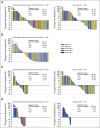Randomized, Open-Label Phase II Study Evaluating the Efficacy and Safety of Talimogene Laherparepvec in Combination With Ipilimumab Versus Ipilimumab Alone in Patients With Advanced, Unresectable Melanoma
- PMID: 28981385
- PMCID: PMC6075852
- DOI: 10.1200/JCO.2017.73.7379
Randomized, Open-Label Phase II Study Evaluating the Efficacy and Safety of Talimogene Laherparepvec in Combination With Ipilimumab Versus Ipilimumab Alone in Patients With Advanced, Unresectable Melanoma
Abstract
Purpose We evaluated the combination of talimogene laherparepvec plus ipilimumab versus ipilimumab alone in patients with advanced melanoma in a phase II study. To our knowledge, this was the first randomized trial to evaluate addition of an oncolytic virus to a checkpoint inhibitor. Methods Patients with unresectable stages IIIB to IV melanoma, with no more than one prior therapy if BRAF wild-type, no more than two prior therapies if BRAF mutant, measurable/injectable disease, and without symptomatic autoimmunity or clinically significant immunosuppression were randomly assigned 1:1 to receive talimogene laherparepvec plus ipilimumab or ipilimumab alone. Talimogene laherparepvec treatment began in week 1 (first dose, ≤ 4 mL × 106 plaque-forming units/mL; after 3 weeks, ≤ 4 mL × 108 plaque-forming units/mL every 2 weeks). Ipilimumab (3 mg/kg every 3 weeks; up to four doses) began week 1 in the ipilimumab alone arm and week 6 in the combination arm. The primary end point was objective response rate evaluated by investigators per immune-related response criteria. Results One hundred ninety-eight patients were randomly assigned to talimogene laherparepvec plus ipilimumab (n = 98), or ipilimumab alone (n = 100). Thirty-eight patients (39%) in the combination arm and 18 patients (18%) in the ipilimumab arm had an objective response (odds ratio, 2.9; 95% CI, 1.5 to 5.5; P = .002). Responses were not limited to injected lesions; visceral lesion decreases were observed in 52% of patients in the combination arm and 23% of patients in the ipilimumab arm. Frequently occurring adverse events (AEs) included fatigue (combination, 59%; ipilimumab alone, 42%), chills (combination, 53%; ipilimumab alone, 3%), and diarrhea (combination, 42%; ipilimumab alone, 35%). Incidence of grade ≥ 3 AEs was 45% and 35%, respectively. Three patients in the combination arm had fatal AEs; none were treatment related. Conclusion The study met its primary end point; the objective response rate was significantly higher with talimogene laherparepvec plus ipilimumab versus ipilimumab alone. These data indicate that the combination has greater antitumor activity without additional safety concerns versus ipilimumab.
Trial registration: ClinicalTrials.gov NCT01740297.
Figures





References
-
- Antonia SJ, Larkin J, Ascierto PA: Immuno-oncology combinations: A review of clinical experience and future prospects. Clin Cancer Res 20:6258-6268, 2014 - PubMed
-
- YERVOY, ipilimumab. Bristol-Myers Squibb, Princeton, NJ, 2015
Publication types
MeSH terms
Substances
Associated data
Grants and funding
LinkOut - more resources
Full Text Sources
Other Literature Sources
Medical
Research Materials
Miscellaneous

